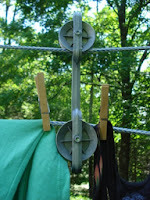Not only are the kilowatt savings significant, but the process of hanging our clothes outdoors in the early morning and taking them down in the evening is one of the "chores" I truly enjoy. Planning a clothesline takes thought to ensure that the location is convenient and aesthetically pleasing. Ideally the line won't obstruct your view of attractive areas of your yard, and an appealing view from the perch you are standing on to hang your clothes will add pleasure to the task.
1. Try to locate your line in a part of the yard that is not easily seen from your neighbor's home.
2. Locate your line somewhere that is easy to access from one of your exterior doors.
3. Attach one end of the line to the house, if possible—it's much harder to pull down the house with a heavy load than a vertical post—and the other end high off the ground (twelve – fifteen feet) to a tree, braced post, or building.
4. Attach the ends securely using hardware that allows the line to move smoothly.
5. Hang the line so that the distance from the line to the ground is significant, allowing sheets, towels and pants to hang without touching the ground—even when the line is weighted down with clothing.
6. Stand on a bench, if possible, while hanging clothes to avoid raising your hands over your head while pinning.
7. Purchase enough clothes pins so that you can attach the clothes securely to the line without worrying they will fall on a windy day.
8. Use hardware that draws the two lines together to keep the line from being dragged too close to the ground.
9. Hang clothes inside out if they are susceptible to sun bleaching, and give clothes a quick “snap” before hanging to help shake out wrinkles.
10. Watch the weather—but don't worry too much, because a little rain doesn’t hurt your clothes; it just prolongs the drying process.
A clothesline is one of the simplest, least expensive, low-tech solar devices on the market.








No comments:
Post a Comment